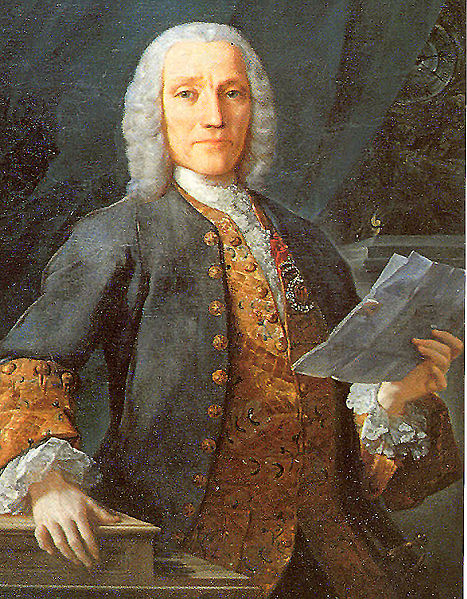<Back to Index>
- Mathematician Ferdinand Georg Frobenius, 1849
- Composer Giuseppe Domenico Scarlatti, 1685
- Président de la République Française François Maurice Adrien Marie Mitterrand, 1916
PAGE SPONSOR

Giuseppe Domenico Scarlatti (Naples, 26 October 1685 – Madrid, 23 July 1757) was an Italian composer who spent much of his life in the service of the Portuguese and Spanish royal families. He is classified as a Baroque composer chronologically, although his music was influential in the development of the Classical style. His influential 555 sonatas were almost all written for the harpsichord with a few exceptions for chamber ensemble or organ. He was the son of composer Alessandro Scarlatti. Domenico Scarlatti was born in Naples, Kingdom of Naples, in 1685, the same year as Johann Sebastian Bach and George Frideric Handel. He was the sixth of ten children and a younger brother to Pietro Filippo Scarlatti, also a musician. He most likely first studied under his father, the composer and teacher Alessandro Scarlatti; other composers who may have been his early teachers include Gaetano Greco, Francesco Gasparini, and Bernardo Pasquini, all of whom may have influenced his musical style. He became a composer and organist at the royal chapel in Naples in 1701. In 1704, he revised Carlo Francesco Pollarolo's opera Irene for performance at Naples. Soon after, his father sent him to Venice; no record exists of his next four years. In 1709 he went to Rome in the service of the exiled Polish queen Marie Casimire, where he met Thomas Roseingrave. Scarlatti was already an eminent harpsichordist: there is a story of a trial of skill with George Frideric Handel at the palace of Cardinal Ottoboni in Rome where he was judged possibly superior to Handel on that instrument, although inferior on the organ.
Later in life, he was known to cross himself in veneration when
speaking of Handel's skill. In Rome, Scarlatti composed several operas for Queen Casimire's private theatre. He was Maestro Di Cappella at St. Peter's from 1715 to 1719. In 1719 he travelled to London to direct his opera Narciso at the King's Theatre. According to Vicente Bicchi (Papal Nuncio at the time), Domenico Scarlatti arrived in Lisbon on 29 November 1719. There he taught music to the Portuguese princess Maria Magdalena Barbara.
He left Lisbon on 28 January 1727 for Rome, where he married Maria
Caterina Gentili on 6 May 1728. In 1729 he moved to Sevilla, staying
for four years and gaining a knowledge of flamenco.
In 1733 he went to Madrid as music master to Princess Maria Barbara,
who had married into the Spanish royal house. When the Princess became
Queen of Spain Scarlatti remained in the country for twenty-five years,
where he had five children. After the death of his wife in 1742 he
married a Spaniard, Anastasia Maxarti Ximenes. Among his compositions
during his time in Madrid were a number of the 555 keyboard sonatas for which he is best known. Scarlatti befriended the castrato singer Farinelli, a fellow Neapolitan also enjoying royal patronage in Madrid. The musicologist Ralph Kirkpatrick acknowledged that Farinelli's
correspondence provides "most of the direct information about Scarlatti
that has transmitted itself to our day." Domenico Scarlatti died in Madrid, at
the age of 71. His residence on Calle Leganitos is designated with a
historical plaque, and his descendants still live in Madrid. Only
a small fraction of Scarlatti's compositions were published during his
lifetime; Scarlatti himself seems to have overseen the publication in
1738 of the most famous collection, his 30 Essercizi ("Exercises").
These were rapturously received throughout Europe, and were championed
by the foremost English writer on music of the eighteenth century, Dr. Charles Burney. The
many sonatas which were unpublished during Scarlatti's lifetime have
appeared in print irregularly in the two and a half centuries since.
Scarlatti has, however, attracted notable admirers, including Frédéric Chopin, Johannes Brahms, Béla Bartók, Dmitri Shostakovich, Heinrich Schenker, Vladimir Horowitz and Marc-André Hamelin. The Russian school of pianism has particularly championed the sonatas. Frédéric Chopin, as a piano teacher, notably wrote: Scarlatti's 555 keyboard sonatas are single movements, mostly in binary form,
and are almost all intended for the harpsichord (there are four for
organ, and a few where Scarlatti suggests a small instrumental group).
Some of them display harmonic audacity in their use of discords, and
also unconventional modulations to remote keys. Other distinctive attributes of Scarlatti's style are the following: The harpsichordist Ralph Kirkpatrick produced
an edition of the sonatas in 1953, and the numbering from this edition
is now nearly always used – the Kk. or K. number. Previously, the
numbering commonly used was from the 1906 edition compiled by the
Neapolitan pianist Alessandro Longo (L. numbers). Kirkpatrick's
numbering is chronological, while Longo's ordering is a result of his
grouping the sonatas into "suites".